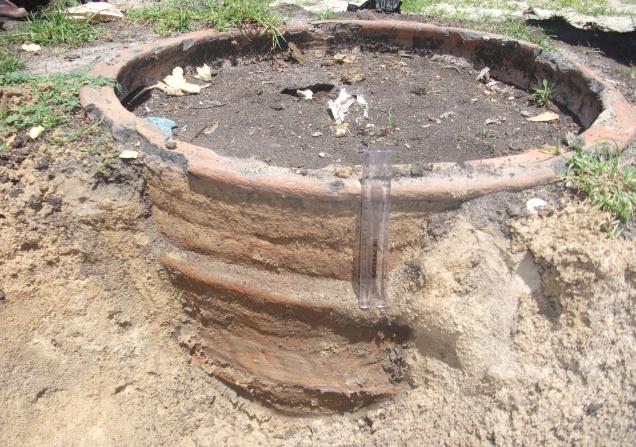
“These stand testimony to the fact that Chola culture was quite predominant in Chidambaram”
Voluntary efforts being made by the people of Chidambaram town to desilt and revive the Oma Kulam have brought out the historic significance of the ancient waterbody.
After the five-foot high siltation was removed, the place has now revealed the existence of two terracotta ring wells dating back to the 12th Century AD. This was vouchsafed by J.R. Sivaramakrishnan and P. Kalaiselvan, assistant professors of History Department at Annamalai University.
Mr. Sivaramakrishnan told The Hindu that terracotta ring wells were very common structures prevalent during the Chola period. These two wells found on the now defunct waterbody stood testimony to the fact that the Chola culture was quite predominant in the temple town of Chidambaram.
“Each terracotta ring measures 4 cm in thickness, 12 cm in height and 65 cm in diameter. These rings are usually placed in a well sunk in a sandy soil. Besides these two terracotta structures, four wells constructed with brick walls too have been detected in the Oma Kulam,” he said.
The waterbodies were known by two different names in Tamil: ‘Keni’ and ‘Kinaru.’ The ‘keni’ was the one dug in sandy soil and happened to be the perennial source of water supply whereas, ‘kinaru,’ surrounded by brick structure, used to yield water seasonally.
The term ‘keni’ also found place in a couplet in the Tirukkural where it is stated that the deeper the ‘keni’ is dug, more abundant would be water availability. Similarly, one’s horizon of knowledge would be broadened with constant study, the couplet describes.
Mr. Sivaramakrishnan also noted that traces of Chola period could be found at Kondareddipalayam and Kanisapakkam near Panruti, at Vada Hari Rajapuram near Bhuvanagiri, Maruvai near Vadalur and Vada Rangam near the Kollidam.
These were thickly-populated places during the Chola rule. He also said that other brick wells too must be at least 250-year-old. “Therefore, it could be safely assumed that Oma Kulam played a vital role in the spiritual and social life of the people of Chidambaram.”
The legend has it that Thiru Naalai Povar Nayanar alias Nandanar used to make his ablutions in the wells and offered prayers to Lord Nataraja from there. As he constantly put off his visit to the hallowed precincts of the temple ‘the next day’ (which earned him the nick name Thiru Naalai Povar — one who would go tomorrow), he replied stoically that he would do so in different form.
It was stated that Nandanar entered into the flames of yagna, performed at the Oma Kulam, and came out unscathed. Thus, the waterbody had come to be known as Oma Kulam.
People from all walks of life have been taking active role in the desilting operation that began on August 1 under the aegis of the Hindu Temple Protection Committee.
Social activists, nature lovers and believers want encroachments on the southern side of Oma Kulam to be cleared and sewage lines diverted to preserve the sanctity of the place and restore its past glory.
source: http://www.thehindu.com / The Hindu / Home> News> National> Tamil Nadu / by A. V. Raghunathan / Chidambaram – September 26th, 2013